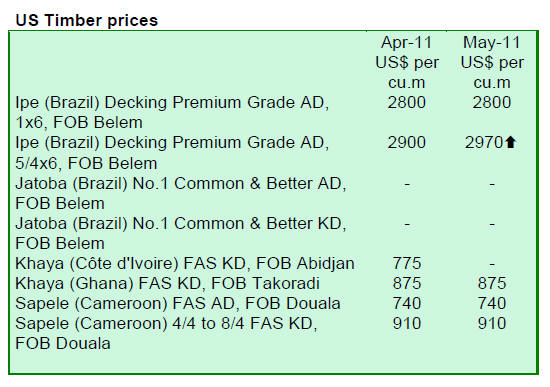|
Report
from
North America
EPDs due in the N. American market
Environmental product declarations (EPDs) are
standardised reports that communicate life-cycle
assessment (LCA) data about products or services. EPDs
are on the rise in the construction sector in Asia and
Europe, particularly in Japan, Korea, France and Sweden.
New EU regulations may mandate the use of EPDs in the
construction industry. Through EPDs companies can
attach LCA-based labels to products that convey their
environmental performance from resource extraction,
manufacturing, usage to disposal.
Unlike other environmental labels EPDs are not a seal of
approval, but they are a tool to bring LCA data to the
marketplace and allow side-by-side comparison of
products.
In the US and Canada, the green building sector has seen
enormous growth, but green building certification systems,
such as LEED, currently do not use EPDs to improve the
environmental performance of buildings.
EPDs present an opportunity for the wood products
industry to better communicate the environmental
performance of wood and to improve the competitive
position of wood versus other buildings materials.
EPDs may also represent non-tariff trade barriers if
countries in Asia or the EU move to mandatory labelling.
This is the position of the American Hardwood Export
Council, who commissioned a large LCA study of
American hardwoods in 2010 that will provide the
database necessary to produce EPDs. The Canadian forest
research institute.
FPInnovations based in Vancouver Canada, conducted
EPD market studies in 2010 and 2011 and concluded that
it is in the best interest of the wood products industry to
accelerate North American activity in EPDs and position
itself as a leader in sustainability among building material
industries.
US finds evidence of dumping by flooring suppliers
The US Department of Commerce, International Trade
(Commerce) has announced preliminary results of its
antidumping investigation of imports of multilayered
wood flooring from China. Commerce found evidence of
targeted dumping by Chinese suppliers and is to
implement antidumping penalties.
The petitioner for this investigation is the Coalition for
American Hardwood Parity, an ad hoc association of U.S.
manufacturers of multilayered wood flooring.
The merchandise covered by the investigation is
multilayered wood flooring, composed of an assembly of
two or more layers or plies of wood veneers in
combination with a core.
U.S. imports of wood flooring from China total nearly
US$120 million in 2009, down from US$148 million in
2008.
U.S. manufacturers said the U.S. recession was the cause
of the decline and have argued that without protective
duties China was positioned to grab a bigger share of the
U.S. market as the economy recovered. Commerce will
issue its final decision on duty levels in August.
See: http://ia.ita.doc.gov/download/factsheets/factsheet-prc-mwfprelim-
20110520.pdf
Rise in year- on- year tropical sawn imports
US imports of sawn tropical hardwood fell in the first
quarter 2011 after four consecutive monthly gains in late
2010. The US imported 49,626 cu.m. in the first quarter,
down from 60,838 cu.m. in the final quarter of 2010 (-
18%).
Year-to-date however, import volumes of tropical
sawnwood increased by 25% compared with March 2010.
Among the species that gained significantly year-to-date
are ipe (+34%), sapelli (+109%), keruing (+158%) and
cedro (+76%). Year-to-date March imports of jatoba (-
57%) and teak (-46%) declined from 2010.
On a monthly basis, imports of sawn tropical hardwood
increased by 8% to 16,187 cu.m. from February. Imports
of acajou d¡¯Afrique, keruing, mahogany, cedro, jatoba,
teak and other, not specified hardwoods grew after mostly
weak imports in February. Balsa imports fell by -16% to
3,328 cu.m. in March.
The two largest suppliers to the US market, Ecuador and
Brazil, decreased exports by -23% and -20%, respectively.
Cameroon increased sawn tropical hardwood shipments in
February, mostly in acajou d¡¯Afrique sawnwood, and this
trend continued in March.
Malaysian exports grew by 23% in March due to strong
keruing shipments. Monthly import volumes of key
imported species by country of origin are shown below.
Major plywood exporters see first quarter decline in US demand
The US imported US$85 million worth of hardwood
plywood in March 2011, down -16% from February but up
8% compared with year-to-date 2010. All major suppliers
saw a decline with the exception of Ecuador who
increased shipments to the US by 35% from February.
Imports from China, the dominant supplier, went down by
20% in March to US$56.3 million and China¡¯s share in
total US hardwood plywood imports dropped from 70% in
February to 66% in March.

Related News:
|